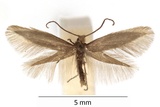Ocnerostoma friesei Svensson, 1966 Species
Last modified: Dec. 10, 2025, 12:03 p.m.
A rare species in Belgium, distribution insufficiently known due to the difficulty with Ocnerostoma piniariella.
Distribution is based only on individuals that have been checked for genitalia.
This species is believed to be much more common than Ocnerostoma piniariella.
Details
- Classification
- Family: Yponomeutidae > Subfamily: Yponomeutinae > Genus: Ocnerostoma > Species: Ocnerostoma friesei
- Vernacular names
- Voorjaarsnaaldkwastje (NL)
- Synonyms
- Ocnerostoma copiosella sensu auct., nec Frey 1956
- First mention in Belgium
- De Crombrugghe G. 1906a. Catalogue raisonné des Microlépidoptères de Belgique. — Mémoires de la Société entomologique de Belgique XIII: 1–172; XIV: 1–155. On page 13.
- Status
-
Native
Distribution
Imago
To reliably separate Ocnerostoma friesei from Ocnerostoma piniariella, it is usually necessary to refer to dissection of the genitalia, although Ocnerostoma piniariella has whitish or grey antennae with white rings, compared to the present species which has wholly grey antennae.
Forewing male pale grey and white in the female with slightly greyish colour along dorsum.
Flight periods
The adults fly in two or three generations a year from March to late August, occasionally later.





